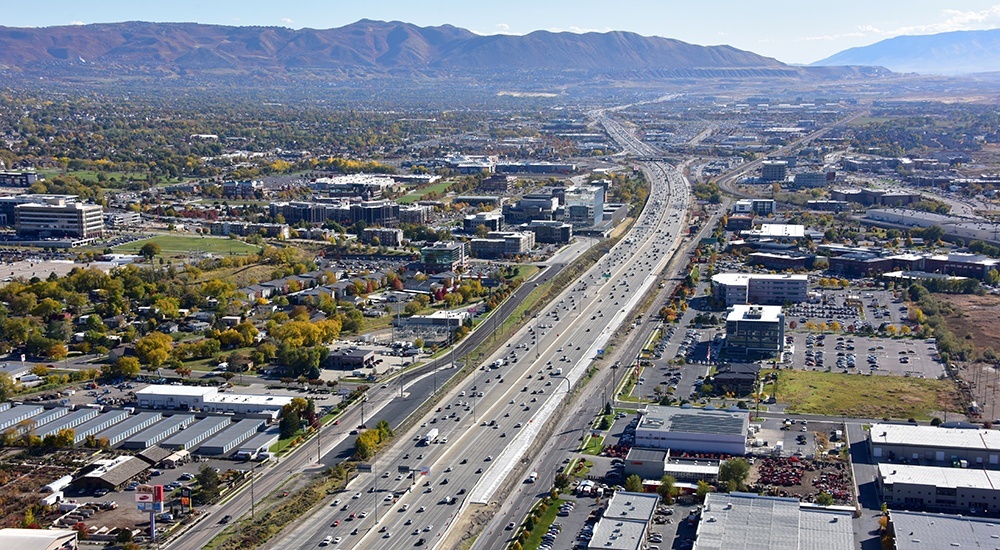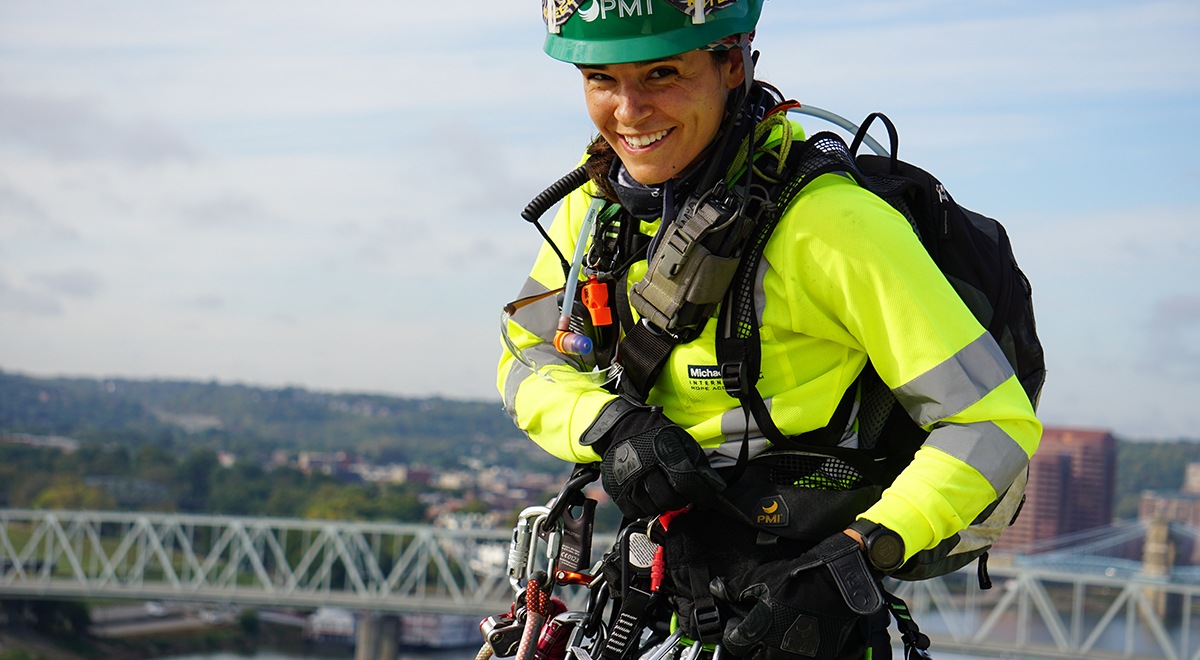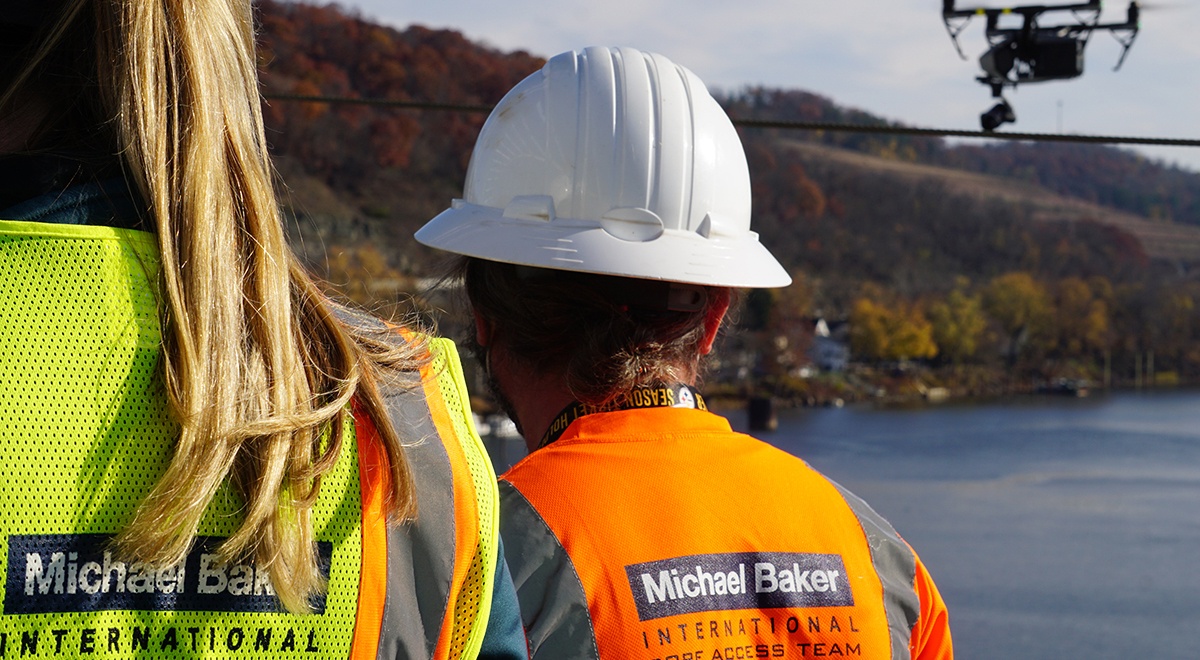Michael Baker designs lead the way to I-15 upgrades
From the Summer 2021 issue of Signature
Interstate 15 is one of Utah’s most important highways, carrying more than 250,000 vehicles each day. That heavy volume includes both passenger traffic and trucks shipping goods across the United States and western Canada, making I-15 a vital commercial corridor.
To keep pace with the state’s burgeoning population, the Utah Department of Transportation (UDOT) has undertaken multiple initiatives to upgrade I-15, with Michael Baker International providing design services for a number of those projects.
But in 2018, UDOT faced perhaps its biggest I-15 challenge yet. Near the cities of South Salt Lake, Murray, Midvale, Sandy and Draper, traffic was backing up on a southbound stretch of the highway that no longer could effectively handle the load. The subsequent logjams were causing related problems along access/exit ramps and feeder highways. Not only were motorists and cargo shipments slowed by as much as 50 minutes, according to UDOT, but the ensuing emissions from snarled traffic were adversely affecting air quality.
The solution: design and construct another southbound lane on I-15 as the centerpiece of a $161.4 million development that would incorporate all associated upgrades into the merges with local highways. UDOT engaged Michael Baker to provide design and engineering services and Ralph L. Wadsworth Construction Co. (RLW) as the primary contractor in a design-build approach.
ENORMOUSLY SIGNIFICANT, ENORMOUSLY COMPLEX
The project was enormously significant — and equally complex. The new lane would stretch for approximately 13 miles, presenting a challenge in itself. Project goals also included improving movements from eastbound and westbound I-215 to southbound I-15 and expanding 7200 South to the west of the freeway to improve traffic flow. In addition, the far-reaching initiative required design and implementation of drainage extensions, detention pond modifications and lighting updates.
The numbers were positively daunting. The Michael Baker-RLW team needed to rehabilitate, widen or narrow 13 bridges, including several that traverse beneath or above active railroad tracks; design and construct roughly 30 retaining walls that, in most cases, would be located 12 to 15 feet behind existing retaining walls; and accomplish all of this while maintaining traffic flow throughout the project. Jon Ogden, Resident Engineer for UDOT’s Region 2 and Manager of the I-15 upgrade, calls it “one of the more difficult projects I’ve seen.”
“When you’re adding a lane to the highway, you’re adding a lane to the existing structures as well. On top of that, adjacent property reached nearly to the highway, restricting our access,” Ogden says.
Meeting the many interrelated challenges required innovation and a high degree of collaboration between Michael Baker and the contractor, RLW. To that end, the two companies and UDOT co-located in a project-site office in Murray to guarantee the swiftest and most comprehensive information sharing. In addition, the design-build partners reached out to designers, engineers and executives in more than a dozen Michael Baker offices to tap their wide-ranging expertise. With that diverse, multitalented support group in place, the team went to work.
FIRST AND FOREMOST: KEEP TRAFFIC MOVING SAFELY
Keeping traffic flowing smoothly throughout the project was one of UDOT’s most important priorities, as Ogden notes: “One of the main goals was to keep traffic moving safely. We wanted everything done in a safe manner — first and foremost. That definitely was an area of focus.”
To that end, the team used off-peak hours to install signage, including 17 overhead cantilever signs, seven overhead median butterfly signs, three VMS bridges and eight sign bridges.
“We were allowed some disruptions during those hours,” says Dayle Coburn, P.E., Design-Build Manager in Michael Baker’s Salt Lake City office. “We did shut down a lane for those operations. We installed a couple overhead signs overnight and on weekends.”
During peak hours, though, the team relied on barriers to keep traffic flowing. Says Darren Burton, P.E., Project Manager – Highway, also in Michael Baker’s Salt Lake City office: “We had temporary barriers separating the work zone from traffic pretty much the entire 13 miles of the project zone.”
Retaining walls posed yet another challenge. New walls, encompassing more than 125,000 square feet, would be tall, soaring to 30 feet or more, yet their design and construction were complicated by their proximity to existing retaining walls that could not be removed or modified. One particularly cramped point allowed only three feet between the old and new walls. The team stepped up to this challenge in an unusual way.
“We ended up using cellular concrete for the new retaining walls,” Coburn says. “We don’t use a lot of it on roadway projects, but it’s not as heavy as standard concrete and it fills the entire gap between the old and new walls.”
The deployment of lightweight concrete limited roadway settlement and reduced irregularities in the driving surface as well as impact on adjacent facilities both inside and outside the UDOT right-of- way — important benefits, all.
ENTER THE GANTRY CRANES
Perhaps the most sensitive, intricate aspect of the project was its extensive bridge redesign and rehabilitation. This was especially true where sections of highway or ramps span active rail lines of the Union Pacific Railroad and the Utah Transit Authority. Rolling out heavy equipment to handle bridge modification at those key sites would have disrupted railroad traffic, an unacceptable approach.
Instead, the team devised an ingenious solution — build giant gantry cranes on site to facilitate bridge widening and narrowing, then disassemble the cranes and remove them once the work was completed. The gantry cranes were instrumental in allowing the team to remove and erect girders weighing more than 1,000 lbs. per foot and standing over 10 feet tall — without affecting rail traffic. It was a remarkable feat, a sight that caused even veteran engineers to marvel.
“The gantry cranes have one set of tires on one roadway, and the other set on another roadway, so the cranes span the gap between the highways. I’d never seen that before. It was really fascinating to see,” Burton says.
PRETTY CLOSE TO PERFECT
The I-15 upgrade was substantially completed in 2020, and it has brought several important benefits to motorists and residents of all the cities along the interstate. UDOT estimates that travel time through the former construction zone was reduced by an estimated 25 minutes — a pre- COVID-19 measurement. Once the pandemic reduced highway travel generally, I-15 logjams virtually disappeared. And while I-15 traffic will reach normal levels eventually, the upgrade has significantly shortened trips for motorists and truckers, while bridge and ramp rehabilitation has improved safety on I-15 connectors. On the environmental front, air quality is improved due to reduced emissions from backed-up traffic.
“Some of the ramps had immediate merges with I-15, which presented some real safety issues,” Burton says. “We designed acceleration lanes to fix that.”
The elegant solutions that the Michael Baker- RLW team designed and implemented made this I-15 upgrade a success across the board. There was even an aesthetically pleasing outcome. For more than 67,000 square feet of newly erected noise walls, the team used five different panel patterns that match the mountain scenes displayed on existing noise walls on both sides of the I-15 corridor.
“The design for the entire project was done with attention to detail and quality,” Ogden says. “There were no substantial misses in the plan. I don’t know if you’ll ever get a perfect plan, but Michael Baker came pretty close to that.”
The project has earned other important recognition as well. It won the 2020 Keep Utah Moving award from UDOT — the agency’s top project award each year — a Grand Award from the American Council of Engineering Companies of Utah, the Utah Construction & Design Magazine 2020 Most Outstanding Project Award in the design-build category, and the Highway Project of the Year (15+ Million) from the Associate General Contractors of Utah.
For Coburn, completion of the project brought special satisfaction. For the last quarter century, he has played a critical role on multiple I-15 upgrades. In fact, the first was designed to prepare the highway for the influx of traffic expected for the 2002 Winter Olympics in Salt Lake City. That $1.3 billion initiative was considered the nation’s largest design-build project at that time.
“I-15 is 400 miles long, but I’ve probably worked on over 100 miles of it,” he says. “It’s good that we keep having to add lanes and repair old pavement. It means we’re growing.”
Coburn, though, downplays his role in that phenomenal growth.
“I don’t talk about it much. If I do, people just turn up the car radio,” he jokes.
Thanks in part to Coburn’s longtime and consistent leadership, as well as the contributions of the entire Michael Baker team, the ride along those miles is quicker, smoother and safer.




